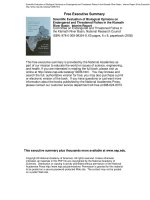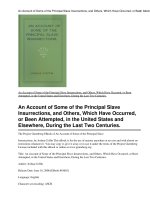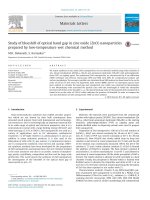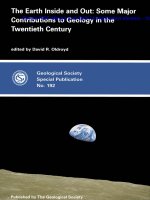Study of some biological indicators of soil in the zone of technogenic factor (on the Example of Cement Plant “Holcim”-Azerbaijan)
Bạn đang xem bản rút gọn của tài liệu. Xem và tải ngay bản đầy đủ của tài liệu tại đây (306.57 KB, 5 trang )
Int.J.Curr.Microbiol.App.Sci (2019) 8(3): 2103-2107
International Journal of Current Microbiology and Applied Sciences
ISSN: 2319-7706 Volume 8 Number 03 (2019)
Journal homepage:
Original Research Article
/>
Study of Some Biological Indicators of Soil in the Zone of Technogenic
Factor (on the Example of Cement Plant “Holcim”-Azerbaijan)
L.A. Aliyeva*, I.X. Babayeva, S.Y. Qasimova and V.K. Isayeva
İnstitute of Microbiology of ANAS, Azerbaijan
*Corresponding author
ABSTRACT
Keywords
Biological
indicators,
Microorgamizms,
Enzyme activity,
Soil pollution,
Toxic effect
Article Info
Accepted:
18 February 2019
Available Online:
10 March 2019
Some biological indicators of soils in the zone of technogenic factor (on the
example of cement plant “Holcim”-Azerbaijan) were studied. Changes in
the quantitative composition of microorganisms, soil respiration, enzyme
activity, degree of urea decomposition are being observed in the soil
samples. The results of the biotesting showed that soil samples from four
sites had a toxic effect on Dafnia magna, Chlorella vulgaris and soil
nematodes.
Introduction
The rapidly increasing rates of anthropogenic
degradation of natural and artificial natural
communities, which are characteristic of our
time, have a complex impact on all
components of the soil. As a result of
technogenic pollution, many natural systems,
including soils, are changed or destroyed,
which ultimately leads to the loss of their
ecological and production functions, as well
as fertility-their main and most valuable
property (2, 3). The main source of biotopes
are the emissions resulting from the activities
of factories. For example, the cement industry
owns most of the gaseous, liquid and solid
waste. The process of soil pollution is
completely different from water and air
pollution. The soil, having a more
complicated and complex structure, responds
to contamination by imbalance between its
components, formed over a long period of
time. Soil properties lead to the fact that
pollutants remain in the soil long after
contamination (4, 5, 6). On the use of
biochemical and biological methods to study
the ecological state of soils, as well as
changes in the composition of the microbial
community has accumulated a significant
amount of information. As is known, the
2103
Int.J.Curr.Microbiol.App.Sci (2019) 8(3): 2103-2107
biological activity of the soil takes the lead in
biomonitoring and soil biodiagnosis. Such
indicators of biological activity of soils as
parameters of accumulation of some products
of activity of soil organisms, the number of
different groups of soil biota, the activity of
the main processes associated with the cycle
of elements are often used (1,6).
An important role in soil biodiagnosis plays
the definition of soil respiration and enzyme
activity as the indicators of the functioning of
the total biota. Various methods are used to
study the biological activity of soils:
biochemical, microbiological, chemical and
physiological (2).
The aim of the present work was to study
some indicators of biological activity of soils
affected by industrial pollution, which was
first carried out in the area of the cement plant
"Holcim" - a large cement-producing plant
located in Garadagh District of Azerbaijan.
Materials and Methods
“Holcim” (Azerbaijan) is a part of Lafarge
Holcim Group, which is one of the world’s
leading suppliers of cement and aggregates.
“Holcim” is one of the leading cement and
clinker manufacturing company in Azerbaijan
(Fig. 1). The object of the study was graybrown soil samples taken from five sites
located at different distances from the cement
plant. The first soil sample was taken at a
distance of 100 m, the second – at a distance
of 500 m, the third - at a distance of 1500 m,
the fourth – at a distance of 2500 m, the fifth
– 5000 m from the border of the cement plant,
taken as a control. Biological activity of soils
was estimated by quantitative characteristic of
microbiota (8), degree of urea decomposition,
intensity of soil respiration and enzyme
activity (7).
Biotesting of soil samples was carried out
according to the standard procedure.
Representatives of unicellular green algae,
planktonic crustaceans and soil nematodes
were used as test objects. The toxicity index
of the factor was calculated by Kabirov R. R.
Results and Discussion
The analysis of the quantitative composition
of the microbiota of soil samples (Table 1)
showed that the number of microorganisms
belonging to different taxonomic groups
varies depending on the place of taking soil
samples: there is a decrease in the number of
microorganisms compared with the control
zone in I, II, III, IV soils sites. As can be seen
from the table, the quantitative composition of
microorganisms belonging to different
taxonomic groups has changed to some extent
in all soil samples of the studied areas. The
number of bacteria and micromycetes
decreases in all soil samples. However, there
is a slight decrease in the number of fungi
compared to the control. These indicators also
suggest that fungi are more resistant to
contamination than bacteria.
In the course of the studies, there was a
change in the biological activity of the studied
soils. Thus, in soil samples (I, II, III), located
at different distances from the cement plant,
the indicators were consistently low. The
average value was observed in soil samples
IV and V, indicating a slight negative effect
of cement plant emissions. The decrease in
the rate of ammonia release and the blue
staining of the indicator paper was an
indicator of a decline in biological activity.
As a result, the process of urea metabolism in
the studied soils is slowing down (tab.2).
The decrease in biological activity in the first,
second and third soil samples were assessed
as evidence of impaired soil metabolism. This
state of the soil creates unfavorable conditions
for the life of plants, protozoa and
microorganisms. This was reflected in soil
samples I and II.
2104
Int.J.Curr.Microbiol.App.Sci (2019) 8(3): 2103-2107
Studies have found that each type of soil
creates a certain level and ratio of enzyme
activity, which determines the intensity and
direction of soil biochemical processes. In
texnogenic landscapes accumulation and
transformation of organic matter are
manifestations of soil formation, and these
processes also occur with the participation of
enzymes, among which an important place
belongs to the redox enzymes. Enzyme
activity is associated with the intensity of soil
respiration. In connection with the above, we
studied the activity of peroxidase and the
intensity of soil respiration of the studied soil
samples. As can be seen from the table 3, soil
respiration and activity of the enzyme
peroxidase of the studied sites were weak
compared to the similar indicators for the
soils of the control site. Apparently, this can
be caused by the presence of heavy metals in
these soils, in particular lead, since it is this
metal that has a strong effect on the activity of
enzymes such as acid phosphatase, malate
dehydrogenase and peroxidase.
Toxicity of the studied soils was determined
by biotesting. Chlorella vulgaris, Daphnia
magna and soil nematodes were used as test
objects.
In our experiments, the death of 50% or more
of Dafnia magna and soil nematodes within
96 hours were taken into account as a criteria
of toxic action. The data obtained showed that
I, II, III, IV soil samples were toxic. In the V
soil sample no toxicity was observed.
According to the Chlorella data, the toxicity
of each of the four soil samples was
identified, which makes it possible to
calculate the toxicity factor index (ITF).
Comparison of the results was carried out by
the method of Kabirov (6), the range of 0.911.10 was taken as the norm.
Table 1 The number of microorganisms in the soil samples of the investigated areas
Samplingsites
The number of microorganisms
Bacteria (104 CFU/q)
Micromycetes (CFU/q103)
I
90
58
II
104
60
III
115
62
IV
120
65
V (control)
132
68
Note: I-100 m, II–500 m, III–1500 m, IV–2500 m, V- 5000 v (control), CFU-colony-forming unit
Table.2 Urea decomposition rate in soil samples (2016-2017years)
Years
Biological activity in soil samples
I
II
III
IV
V (control)
2016
low
low
low
medium
medium
2017
low
low
low
medium
medium
2105
Int.J.Curr.Microbiol.App.Sci (2019) 8(3): 2103-2107
Table.3 Peroxidase activity and of soil respiration in the studied areas
Soil samples
Peroxidase,
activity purpurogallin,
(mq) (2016)
Soil
respiration,
CO2
(mq/100q/h) (2016)
Peroxidase,
activitypurpurogallin,
(mq) (2017)
Soil
respiration,
CO2
(mq/100q/h) 2017
I
1,8
II
1,83
III
1,83
IV
1,90
V (control)
1,92
0,63
0,63
0,66
0,72
0,81
1,78
1,81
1,82
1,92
1,92
0,62
0,64
0,65
0,71
0,80
Table.4 Toxicity of the soil samples
Soil samples
DafniaMagna, %
I
II
III
IV
V(control)
83
77
70
60
43
toxicity
Soil
nematodes,%
64
60
57
54
44
TFI
0,3
0,5
0,7
0,7
0,96
Note: TFI– toxicity factor index; I-norm, II- weak, III – medium,IV – high
Fig.1 Cement plant "Holcim"
2106
Chlorellavulgaris
Degree of toxicity
IV
III
II
II
I
Int.J.Curr.Microbiol.App.Sci (2019) 8(3): 2103-2107
The results show that soil samples from all
four sites have toxic effects on Dafnia Magna
and soil nematodes (Table 4).
4.
The data on biotesting obtained on Chlorella
showed the following: in III and IV soil
samples weak, in II – medium, in I-m – high
toxicity was observed.
In conclusion, the results of biotesting may
indicate the presence of toxic effects, which
are probably due to soil contamination as a
result of the functioning of the cement plant.
Therefore, indicators of biological activity of
soils can be used in environmental monitoring
of technogenically disturbed areas.
5.
6.
References
1.
2.
3.
Aristovskaya T.V., Chugunova M.V.
1989. Rapid method for determining the
biological activity of soil. Soil science,
11:142-147.
Babayev A.H. 2011. Soil quality
monitoring and environmental control.
Baku, publishing house “Law”, 263.
Bakhshaliyeva K.F. 2017. General
characteristics
of
mycobiota
of
7.
8.
technogenic soils. Proceedings of the
Institute of Microbiology of ANAS,
15,1: 279-287.
Vetrova S.N. 1991. Ecological and
trophic characteristics of soil nematodes
in the conditions of industrial pollution.
Abstracts of the scientific conference
"Evolutionary theory and problems of
phytohelminthology", Moscow, Pp. 2526.
Isabekova B.S., Bekbolotova K.A.,
Mambetova G.A. 2014. Influence of
cement production on the environment.
Proceedings of KSTU named after. I.
Razzakova, 33:485-486.
Kabirov R.R. 1997. Development and
use of multicomponent test system for
assessing the toxicity of the soil cover of
urban areas. Ecology, 6:13-15.
Kazakova N. A. 2014. Changes in
microbial composition and soil toxicity
in the zone of influence of cement
production emissions. Eurasian Union of
scientists, 4(3): 71-72.
Netrusov
A.I.,
Egorova
M.A.,
Zakharchuk L.M. 2005. Practicum on
Microbiology. Moscow: Academy, 604.
How to cite this article:
Aliyeva, L.A., I.X. Babayeva, S.Y. Qasimova and Isayeva, V.K. 2019. Study of Some
Biological Indicators of Soil in the Zone of Technogenic Factor (on the Example of Cement
Plant “Holcim”-Azerbaijan). Int.J.Curr.Microbiol.App.Sci. 8(03): 2103-2107.
doi: />
2107









